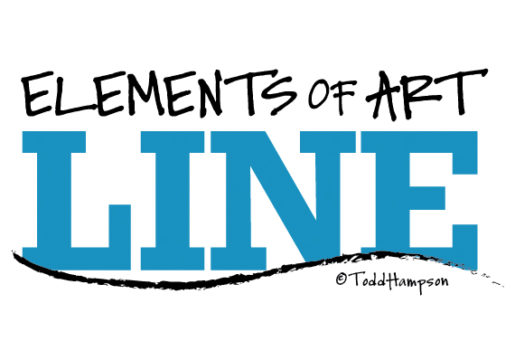
In my Art Direction 101 post I listed the 7 Elements and 7 Principles of Art. I want to write a post on each of them to explain their role in art direction for composition and motion media.The line is the most basic building block of an artistic piece. It’s basically a moving dot and there are some basic things to remember about how line can influence emotion and how it can guide the viewers eye.
As an artist, you are a story teller, a director, a puppet-master. You control where the eye goes, so it’s very important to understand how your line choices can impact your artistic vision for a piece of art (any art form: animation, video, oil painting, watercolor, illustration, graphic design, etc.). I’ll admit that when I was in art school and heard all of this talk about the elements and principles of art conveying and impacting emotion, I thought it was all heady elitist fluff.
The longer I’m an artist, however, the more I understand these principles and how they work. The more I analyze film and animation, I see (and feel) how these elements are used to guide the eye and effect the emotions. Here are a few tips.
Horizontal LinesHorizontal lines convey calmness and serenity. Imagine a calm sunset setting with a horizon line with no tilt.
Vertical Lines
Vertical lines are slightly more dynamic and convey strength and alertness. Envision a soldier standing at attention, or a sky scraper in the middle of a composition.
Diagonal Lines
Diagonal lines are the most dynamic and convey action. Even in a still image, a leaning figure appears to be in motion. A tilted camera conveys action.
OTHER CONSIDERATIONS
• Line can also give the illusion of form. Contour lines show the “edge” of a character or object.
• Lines can be organic and irregular.
• Line quality can also vary with different thickness/thinness of line. Thicker line has more visual “weight” and can be used for emphasis or guiding the viewer’s eye. Variety creates interest and feels more energetic.
• Cross contour lines show even more form. In addition to the outline, cross contour lines help “map out” the Z-space so to speak. Not so much like a 3D character grid, but finding contours that show the illusion of dimension.
FILM AND ANIMATION
In Film, sequential art, animation it’s critical to think of how the lines play off each other from shot to shot. What emotion does the sequence need? Do you need contrast of affinity as you line up shots or compositional elements? (Contrast basically means “different”, affinity means “the same”). Is it a cross cut sequence between a peaceful meeting and a crazy car chase? Then the line choices should support that. Line also works in conjunction with other elements like space (flat lines vs. perspective).
There are 2 great books I highly recommend. Framed Ink, by Marcos Mateu-Mestre
and The Visual Story, by Bruce Block. Both cover line really well. There are also some great “art of” books for most of your favorite animated films that are great to read as well (mostly regarding art direction for that particular film).
